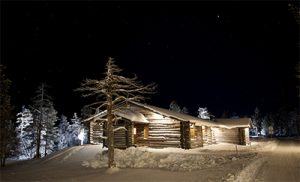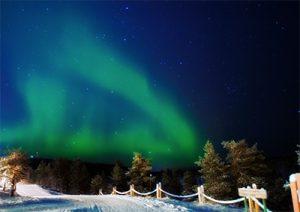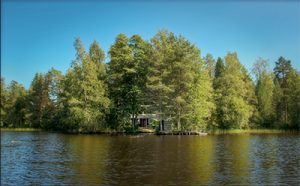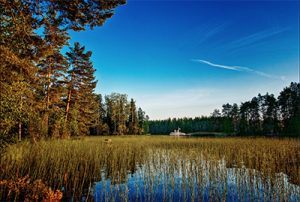by Bill Murray
Hyvä asiakkaamme,
Ethän käytä huoneiston takkaa.
Se on tällä hetkellä epäkunnossa
Ja savuttaa sisään.
Dear customer,
Please don’t use the fireplace. It is for the moment out of order and the smoke comes into the apartment.

Now wait a minute. We might need that fireplace in Lapland in December. Just now it’s three degrees (-16C) outside. The nice lady couldn’t be more sympathetic, but they just manage the place. Fixing the fireplace requires funding that can’t be organized until we are gone.
She promises we’ll stay warm thanks to a magnificent heater, a sauna and the eteinen, one of those icebox-sized northern anterooms that separate the outside from the living area. I have fun with the translation, though. I imagine that fool Ethän has busted the damned fireplace again.
• • •
Welcome to Saariselkä, Finland, where it’s dark in the morning, briefly dusk, then dark again for the rest of the day. The sun never aspires to the horizon. Fifty miles up the road Finland, Norway and Russia meet at the top of Europe.
But look around. It’s entirely possible to live inside the Arctic Circle. It takes a little more bundling up and all, and you need a plan before you go outside. No idle standing around out there.
There are even advantages. Trailing your groceries after you on a sled, a pulkka, is easier than carrying them. There’s a word for the way you walk: köpöttää. It means taking tiny steps the way you do to keep your balance on an icy sidewalk.
Plus, other humans live here, too, and they seem to get along just fine. Infrastructure’s good, transport in big, heavy, late model SUVs, a community of 2600 people, all of them attractive, all of whom look just like each other.
I imagined “selling time shares in Lapland” was a punch line, but it’s an actual thing. A jammed-full Airbus delivered us from Helsinki, one of three flights every day to Rovaniemi.
Down the stairs, across the tarmac and into the dark. The highway spools out with no end, a monochrome tunnel of mist and snow. Finns counter with a flourishing roadhouse culture. Oases appear, of people and movement and light, fast food, a cafeteria and a grill, newsstands, groceries and gasoline.
At floating markets in the Mekong Delta, boats hoist fruit on bamboo poles to advertise they’re selling coconuts, say, or star fruit. Here, totems rise at exits, fog swirling around neon: Pizza! Market! Gas! 24H! Credit Cards!
Seventy kilometers up the road is Inari, Finland’s largest town by area. At 17,321 square kilometers it’s about half the size of Belgium, yet your fridge is likely to be dorm-sized and the biggest carton of milk you’ll find is a liter. Finns are a conserving lot, even with room to spread out.
And the loft in this little apartment, sure it’s for kids (please let it be for kids), but not only can you not walk in it, you can’t crawl in it. A bloody death trap if there were ever a fire. Not that there would be, because the fireplace doesn’t work.
There is a grocery you can walk to, Kuukkeli, down on the highway into town, where you can buy mean and defiant ruisleipä, Finnish rye bread. I know a Lithuanian man who claims they have the same loaves in Vilnius. There are sausages and heat-and-serve casseroles made of beets or mushrooms or potatoes and ham. And tins of moose, bear, elk and reindeer.
If you eat meat you will do best just to capitulate on the reindeer thing. Here in Kuukkeli you can buy reindeer burgers, cold smoked reindeer, reindeer steak, reindeer sausages, reindeer meat pie, smoked reindeer flatbread (this is a hit: in high season Kuukkeli sells 250 a day), reindeer pizza (chopped smoked reindeer, blue cheese and pineapple), reindeer quiche, reindeer soup, smoked reindeer roll, croissants with chopped cold smoked reindeer, reindeer paninis and warm reindeer sandwiches.
•••••
Mark Twain wrote “If the thermometer had been an inch longer we’d have frozen to death” and I feel that way this morning. The hardest thing is getting out of bed. That can be unfortunate if you mean to make something of the day, since it’s night again by 3:00. The last bus runs at 3:40. There is no more light.
 But maybe everybody sleeps in, because come midnight, the lambent auroral sky-dance teases out a parade of the awestruck from a dozen lands. We group together up and down the hills, all of us bundled and round Michelin men, teeth chattering like dice, bouncing and rolling and reveling in how utterly odd is this world.
But maybe everybody sleeps in, because come midnight, the lambent auroral sky-dance teases out a parade of the awestruck from a dozen lands. We group together up and down the hills, all of us bundled and round Michelin men, teeth chattering like dice, bouncing and rolling and reveling in how utterly odd is this world.
• • •
The Nordic countries are Denmark, Finland, Iceland, Norway and Sweden. More exclusively, Denmark, Norway and Sweden are Scandinavian, whose Norse ancestors’ sailing adventures made them accidental people of the world by opening up trade routes across the Baltic, North Atlantic and through mad depradation across Russia to the Black Sea.
The Finns don’t share this heritage, caught in Europe’s invisible corner, their language unrelated to the Scandinavians on this side or the Russians on that. They get not even cold comfort from their Russian border, Europe’s third longest. Perhaps this accounts for Finns’ exquisite taste for silence.
Finns were always ruled from Sweden or Russia, and it’s easy to see why. The world’s stock of Finns is only just enough to constitute a nation. The equivalent of Finland’s entire population transits Tokyo’s Shinjuku station every 38 hours.
Some 5.5 million live in the country and with the diaspora, notably in Sweden and the USA, there are around seven million Finns in all, and they are the only people in the world who speak their language (though their cousins’ Estonian is similar). The whole proposition of “Finland” is fragile. Which makes Finns hold it even more dear.
Change of suzerainty seldom benefits all parties but when Russia took Finland from Sweden (The Napoleonic wars reverberated clear to the Arctic), Sweden gained a buffer against the Tsar and has remained at peace – or neutral – since. Finland’s 1313 kilometer-long border also protected Russia.
A 19th century Finn may have been hard pressed to see any benefit to paying tribute east instead of west, but Finland kept its Lutheran religion, its constitution (with civil and criminal laws), and a free peasantry. Time proved these to be real benefits over living as Russians.
Russia pulled Finland’s capital back from Swedish-facing Turku to Helsinki. They encouraged use of the Finnish language as a bulwark against Swedish influence, rallying incipient Finnish nationalism. The Bank of Finland wriggled free of the ruble into its own currency, the markka. By the end of the 19th century passports held Finns as “Finnish nationals and Russian subjects.”
Finland prospered under Russian protection, provoking elite Russian ire. Alexandr Solzhenitsyn groused that “only a few miles from their capital city Russians had to face Finnish customs inspectors who refused to speak Russian.”
Russian frustration resulted in political meanness around the periphery (some things don’t change). The backlash, a Russification decree mandating Russian lessons, infuriated Finns, and every community organized petitions of grievance.
Suonenjoki is a farm town best known for Mansikkakarnevaalit, its strawberry carnival in July. Even in little Suonenjoki the head of the town council, a school teacher named Otto Alexanderi Solmu, gathered anti-Russian signatures, criss-crossing the countryside on skis during the twenty hours of daily darkness in February, 1899.
A delegation petitioned the Tsar, Solmu among them, many walking to Pietari through the snow. Tsar Nicholas surveyed the freezing lot and dismissed them from the top of a staircase, indicating they could go without punishment, if they would just go.
They took home a sort of imperial consolation prize of Tsarist artifacts, in Solmu’s case teacups, which his granddaughter, my mother-in-law Kaisa, was never allowed to touch for fear she’d break them. We admire the Tsar’s tea service whenever we visit.
• • •
Summer upends winter’s sensory-tamped quiescence with noisy pleasure boats on a thousand lakes, round the clock light and determined, daylong activity. And chain saws. Summer is short. Never too soon to lay back firewood.
We drive to Kuopio, an eastern city four hours north of Helsinki, whose center on a hill falls away to the lake six or eight blocks in every direction. Up on the square, the food trucks’ specialty is Finland’s delicious answer to empanadas and samosas, lihapiirakka, Finnish meat pie.
Today, July 7th, it’s a struggle to 60 (15C) degrees. Everyone in Kuopio wears a jacket or rain slicker or carries an umbrella. Wind whips at clothing. It is not cold but it is determinedly not warm.
Rain is coming, clouds ground-hugging and fat, and we drive south into a full-on drenching. A paving crew looks forlorn on one of the precious days that by all rights they might expect to enjoy working outside.
We are patient with Radio Suomi (Suomi is Finnish for Finland) until a song with the lyrics “dee dee dum” in call and response finally drives us away. The government broadcaster YLE has an English newscast now and then. When they say it, it sounds like “Wily English news.”
Road signs indicate “moose, next 14 kilometers.”
• • •
Our destination is Varkaus, near my wife’s family’s farm.
Varkaus is slow-motion dying, its population shrunk to 20,000. Thirty years ago the paper mill churned out newsprint and full employment. In a post-newspaper world they’re scrambling to manufacture containerboard for the new era of home delivery, but young people aren’t buying in; they’re racing to graduate and evacuate.
I am sitting at a sticky picnic table on the market square opposite the factory, the sky leaden, the ground damp. Boys cycle by, fishing poles across their handlebars. The defunct smokestack across the street, if it fell, would split the town in two.
Kiosk “Pepsi” vends pizza and burgers late into the daylit night. Bar “Oscar” is attached to the Scandic Hotel. Across the square is “Sport Harrison,” open until 4:00 a.m. weekends with a dark entrance, a friendly doorman and a terrace.
One market stall serves fish cooked on a hot plate. Not too close by, for the square is expansive, another offers sweets, and in the third, a t-shirt of a bird hangs over two frame prints, one a bear treading through snow, the other some frightening arctic fish. These are the only three stalls in the marketplace.
There is a bandstand. A hostess with a microphone introduces older men in jackets. She and the men are a cadre. Veterans, perhaps? I don’t know enough Finnish to ask. One at a time the men step up four stairs and stumble through karaoke accordion music. I count an audience of seven. Some sway a little bit with the tunes.
Down at the end of old Main Street beside the swimming hall, a former lodge for the paper mill elite boasts a well-tended lawn. We are staying in one of the four-story blocks of flats between here and there, the one with a Chinese restaurant on the ground floor, red lamp on when it is open, serving a pared down menu under the headings Sea Food, Meat Food and Chicken, Duck Food.
 Like everyone else, though, we own a tiny kesämökki, a summer cabin on the lake not far from town. In summer all of Finland lives lives on the lake.
Like everyone else, though, we own a tiny kesämökki, a summer cabin on the lake not far from town. In summer all of Finland lives lives on the lake.
• • •
Rain at the mökki, pouring all night, thunder in the distance at the night’s least light. Ideally toward August the lake has warmed, but just now it’s scarcely 62 degrees (16C), making it a test of character to jump in there naked, except that is what you do in Finland in the summer.
Challenging as that first plunge is, after you fry in the sauna and dip in the lake, fry and dip and fry and dip, that last time you emerge from the lake self-satisfied as a conquering Asiatic warrior. This is when you heavy-foot like a caveman over to a grill resting across bricks. And eat a sausage.
Lupins wave across fields in tricolor like three flavors of popsicles. Down the path they are neck high. Bull-birds – that’s an approximate translation – a couple, make intimidating noises from their nest that floats on top of the water.
Birch leaves are ill-proportioned, too small for the tree. In the breeze they rub together with the agreeable sound of crisp linen sheets. Squiggles on their trunks mark out lateral space, each a bell curve, a lipstick print, thicker in the middle at the top. A 1920s Parisian barbier’s moustache menu, all the way up the tree.
 The sun never goes down. It won’t be dark for a month. When a gaudy pleasure boat flashes up the main channel it slaps water back this way. The reeds get rocking with the crests of the waves.
The sun never goes down. It won’t be dark for a month. When a gaudy pleasure boat flashes up the main channel it slaps water back this way. The reeds get rocking with the crests of the waves.
In fair weather the bottoms of Finnish clouds are epic blue, irreplicable in photography, never attained in lower latitudes, resonant with the sky. But in twenty minutes the wind transforms the day from cumulized to stratified.
When rain comes it falls straight down, vermicelli-thin, at its leisure, soft and gentle. It makes everything wet just the same though. When it stops the lake is a pane of glass. When it rains it’s ripples and worry.
Today the pleasure boats stay out of the rain. What’s right for today: a novel, sweatshirts, sweatpants and mosquito coils chain smoking on the porch. They’re digging up baby new potatoes this week. By next week they’ll be in all the stews. Even in July Karelian stew is rainy day perfect.
You can sail 300 kilometers clear to the sea from here if you sail around the point, under the bridge then off to the west. Sea birds follow the water all the way here. They accuse each other above the channel buoys, all rattle and fury. They fight at the tip of the little island, then in the middle of the channel. When matters grow sufficiently dire they dive bomb each other.
It’s not good when they attack our ducks, though. We may not be here all year but they are our ducks, because surely mama was one of the chicks we fed last summer. This year there are seven new chicks. We feed them crackers off the dock and worry they’re too tame, but they love the crackers and they all crowd around.
